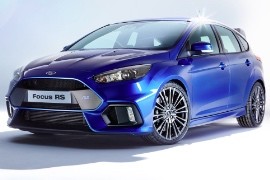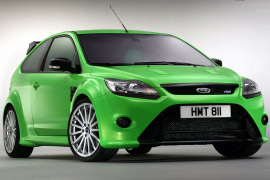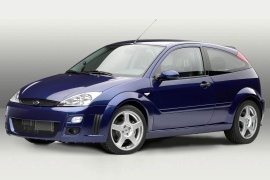

The Ford Focus RS made a wild return on the compact Focus at the 2015 Geneva Motor Show. It is a reminder that Ford, once, won the World Rally Championship and had some high-performance hatchbacks such as the Ford Escort Cosworth. And now, the RS.
The look was fierce, with big bumpers front and rear with air-vents and a wing on the back. A roof spoiler would be an understatement for what what was mounted on top of the liftgate. And that is not only for aesthetic look. The 2016 has zero lift on aerodynamic forces.
The interior featured sport bucket seats, an integrated 8” touch-screen infotainment unit that had parameters monitoring functions.
It was an all-wheel drive beast that run straight for the crown of the hot-hatches territory. Its 2.3-liter turbocharged engine that boosts 320 hp was meant for this. The standard 6-speed manual was geared for performance. It had 350 mm (13.7”) front discs and 302 mm (11.9”) disc brakes on the rear axle.
The 320 hp was sent to the Ford Performance AWD system that was based on twin electronically-controlled clutch packs on each side of the rear drive unit. The system can manage the amount of torque that is sent to each wheel. The AWD system has been tuned to deliver exceptional grip - with lateral acceleration exceeding 1 g.
gasoline engines:
The 2008 Ford Focus RS was the car that threw away the theory that said that an FWD car with more than 200 hp is a torque-steer nightmare. And proved that some theories are just targets.
The 3-door Ford Focus RS received major modifications compared to other versions of the car. From the outside, the front bumper was bigger and received a spoiler plus a huge air scoop. Two air-vents were installed on the hood and, in the rear, a massive wing with winglets replaced the ordinary rear roof spoiler. From the side, the air-vents on the front fenders and the side-sills warned that that was not an ordinary Focus.
The interior was carefully crafted to match the outside look. The Recaro high-performance sports seats were specially designed and trimmed in authentic motorsport microfiber. Each seat is color-matched to the exterior. As an option, Ford offered Ebony black, partial-leather seats. On the dashboard, new analog-dials appeared, showing specific information about boost pressure, oil temperature and oil pressure.
Underneath the bodywork, there was a new suspension system on the front with a system named RevoKnuckle, a system that limits the torque-steer. Another system involved in diminishing the torque-steer was the limited-slip Quaife differential. Thus, the 305 hp, 5-cylinder engine could send its massive 440 Nm (324.5 lb-ft) torque to the front wheels without causing troubles. The Focus RS looked like an angry dog, but with a bite that matched its bark. And it proved it on the Nurburgring Nordschleife in 8m26 seconds. And that was very fast for that era.
gasoline engines:
Ford made a bold move and introduced the RS version in 2002 as the top-performance Focus for the European market, and it stirred the hot-hatch segment.
In those times, Ford was running in the World Rally Championship, but on the streets, it could only offer the ST version, which was a pale shade of its Rally-cousin. It was a good, all-around, hot-hatch, but it was far from what the platform allowed. Ford knew that and asked its racing department to upgrade the Focus. The result was the RS: a car that sported OZ wheels, Brembo brakes, and Sparco seats.
The RS was a stripped-down and rebuilt Focus. At the front, it sported a unique front bumper with a broad grille at the bottom, exposing its intercooler. On its sides, the carmaker installed small fog lights that shared the same area as the parking lights. From the profile, its enlarged wheel-arches and the roof-wing were the only noticeable differences, while at the back, only the RS badge and the oval exhaust were unique to the sporty hot-hatch.
Inside, the Focus RS received high-bolstered Sparco bucket seats at the front, while the bench was the standard one from the rest of the range. On top of the dashboard, the carmaker installed an additional cluster with three big gauges. Strangely, Ford didn't put white dials on the instrument panel, nor a particular steering wheel.
Under the hood, the RS featured a turbocharged 2.0-liter engine that provided 215 hp. Its biggest problem was that it was slower than the mighty Ford Escort RS.